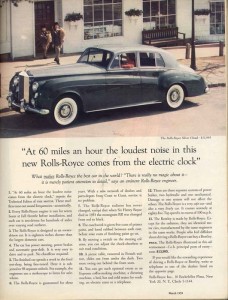One of the greatest ad men in history saw it coming. I’m convinced.
Many ad nerds remember David Ogilvy’s 1958 Rolls-Royce ad for the headline:
“At 60 miles an hour the loudest noise in this new Rolls-Royce comes from the electric clock.”
But what strikes me about that ad (and feel free call me biased here), is the abundance of copy. Informative copy. Not fluffy copy. Thirteen tightly constructed paragraphs describing a feature of the car AND why that feature might matter to the car’s owner. And when Ogilvy’s agency decided to end their relationship with Rolls-Royce and moved on to Mercedes-Benz, the abundance of copy went with them. His ads for the German carmaker focused on the science and engineering that made a Benz a special car. 
So, what is it that I believe Ogilvy saw coming? Well, the kind of thing we do here, actually. In-depth, informative content created to satisfy the need to make informed business decisions. Granted, Ogilvy wasn’t writing for a B2B market, but Ogilvy’s long-form ads read like blog posts before blog posts even existed. Some approach white paper levels of detail. He knew the importance of informing rather than hard selling on big buying decisions. But whereas space was at a premium for Ogilvy (his full-page Rolls-Royce ad ran in two newspapers and two magazines for what would have amounted to a little over $200 thousand in today’s dollars), today’s B2B writing isn’t limited by the same constraints. Its informative potential isn’t limited to a full-page ad or the occasional two-page spread, so B2B writing should be doing more.
Of course, Ogilvy knew that most people never made it past the headline of his ads. Five times as many people read the headline as did the body copy, by his estimation. But those car ads weren’t for the non-readers. They were for the investigators, the researchers, the people who could possibly be pushed from “I would consider spending my considerable expendable income on a luxury vehicle” to “I have to have a Rolls” simply by being more informed about the what and the why.
Today’s B2B writing should keep the same audience in mind. An in-depth exploration about some new government mandated machinery emissions rule may not matter much to everyone, but you can bet it does to the individual who is about to sink a whole lot of capital into satisfying that rule. That person wants to make a purchase based on facts, not fluffy copy.
So B2B copywriters better have their facts in order, and better understand the issues that affect their clients and their client’s customers. In other words, they better do their homework.
Do your homework
Yea, I stole that subhead directly from Ogilvy’s book Ogilvy on Advertising. But I don’t feel too bad, because that headline that I mentioned above, yea Ogilvy stole that from a technical manual for the car he was advertising. That’s not to say he doesn’t deserve any of the credit. He was, after all, the one sifting through the technical literature looking for those little nuggets of wisdom.
And that’s what today’s businesses should expect from their B2B copywriters. Someone who’s willing to get elbow deep in the data sheets, the spec sheets, the safety manuals and the technical brochures. And also, just as importantly, to let the experts do the talking.
“What makes the Rolls-Royce the best car in the world? ‘There is really no magic about it— it is merely patient attention to detail,’ says an eminent Rolls-Royce engineer.”
So much of a B2B copywriter’s job is to let the experts do the talking. To mine their expertise and insight, and to translate some of that brilliance into a dialect the customer is likely to understand. B2B writing should bring your client’s out of the weeds, as my marketing mentor has said.
So my advice to companies looking for great B2B writing would be this: Think of Ogilvy. Produce materials that inform, that answer questions and that respect the intelligence of your customers. Be a trusted advisor. Because potential customers will remember who brought them up to speed when it comes time to buy.
You can learn more B2B and industrial marketing tips on our blog.
